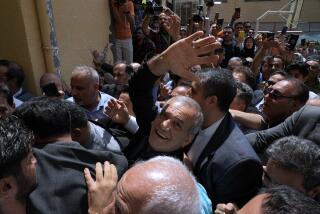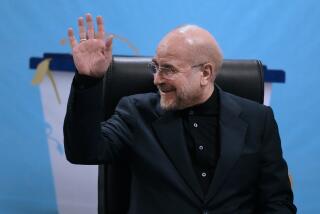Ctrl+shift as Iranian clerics take to Internet
- Share via
QOM, IRAN — This has always been a city with one foot in the present and two in the medieval past. A walk down its dusty main boulevard threads through epochs. Fast food chelo kebab stands and souvenir shops, with wallet-size portraits of the 7th century martyr Imam Hussein, crowd outside the colossal gold and blue domes of the Hazrat Masumeh shrine.
Mullahs in turbans pick their way defiantly through tangled ribbons of cars. Here, in a city that is the revered seat of Iran’s powerful Shiite Muslim clergy and home to 52 Islamic seminaries, women in black chadors emerge from late-model Mercedes-Benzes with tinted windows.
Nowhere is this jarring juxtaposition of old and new more apparent than at the Aalulbayt Global Information Center, the place where Qom’s ancient religious teachings and the Information Age intersect.
Here, stocking-footed men sit behind rows of computer screens in large rooms padded with deep Oriental carpets, typing out Web pages of Koranic analysis and religious edicts translated into 30 languages.
From here, via a server in Santa Clara, Calif., emanates www.al-shia.com, the most widely read source of Shiite proselytizing in the world. Also here is the worldwide communications hub for Grand Ayatollah Ali Sistani, Iraq’s leading Shiite cleric, www.sistani.org, and for Iran’s supreme leader, Ayatollah Ali Khamenei, www.leader.ir.
For years, many of Iran’s clerics resisted a new age’s preference for video screens over ancient Koranic calligraphy. They sanctioned the removal of satellite dishes from rooftops, called for website filtering to guard against pornography and peered at the nation’s budding blogging craze as if it were a bizarre insect that would require new poisons. (“Blogging, due to its mundane nature, has the capacity to nurture the spirit of vulgarity ... [and is] a destructive plague,” Sayed Reza Shokrollahi wrote a few years ago.)
Then they got it.
Now, to browse through Iranian websites is to come upon a flood of pages featuring solemn-looking men wearing beards and turbans. Hundreds of Iranian clerics today have blogs of their own.
Want to know what Khamenei thinks about the U.S. “enemy,” why a proper hezbollahi soldier always has his boots laced, or how Iran is “a modern example of a religious democracy”? Read his website, available in five languages.
Cleric Mohammed Ali Abtahi, who rose to fame as former President Mohammad Khatami’s chief of staff, has since become one of Iran’s most popular bloggers, with his musings (www.webneveshteha.com) now collected in two best-selling books.
Even President Mahmoud Ahmadinejad, though not a religious figure, has a blog (www.ahmadinejad.ir), through which he opines on everything from the “common human spirit” that links Iran and the United States to “the black years” of student repressions under the shah when he was a young revolutionary.
“Qom province is ranked first in Iran in terms of the ratio of population and Internet facilities,” said Ibrahim Lajevardi, the cleric who heads the Aalulbayt. “In every bazaar and alley, you will find the Internet. This is because Qom is one of the most religious cities in Iran, and it was decided to have access to the Internet in order to spread this Islamic knowledge all over the world.”
Qom’s religious leaders hope to build new links between the mother ship and the world’s 150 million Shiite Muslims. But moving Shiism to the Internet is also part of a wider government campaign to rebuild Iran as a geopolitical and technological powerhouse in the Middle East.
In February, Iran launched a research rocket nearly 100 miles into the atmosphere, in part as a step toward launching four new satellites by 2010 and expanding the number of Internet users from 7.5 million to 35 million. A 24-hour, worldwide Englishlanguage news network is scheduled to debut this spring.
“Islam always is in conformance with civilization. If you read history, you will know that Islamic scientists gave their knowledge to early scholars,” Lajevardi said over tea one recent afternoon.
Here in these halls filled with the sound of clicking keyboards, websites are produced for Grand Ayatollah Mohammed Hussein Fadlallah, Hezbollah’s spiritual oracle in Lebanon (www.bayynat.org), and 42 other ayatollahs.
The clerics provide advice on religious questions. (“Is it allowed to employ non-Muslims in my office?” Yes, but better to hire Muslims if you can. “Is it permissible to be party to temporary marriage with a woman who is ‘known for adultery,’ if no other woman is available and the person is in desperate need of marriage?” Not unless she repents.)
Other offices in Qom stray toward politics; some sites deliver the Shiite orthodoxy’s views on everything from relations with Sunni Muslims to the role of the United Nations, the “Holocaust myth” and condemnations of the U.S. campaign in Iraq.
“Iran is growing fast in all aspects -- political, economic and military -- because we have young scholars with open minds who are ready to try new things, make new inventions and do research. This is why countries like the U.S. and Saudi Arabia are worried about Iran,” Lajevardi said.
Iranian government-linked religious websites based on U.S. servers have come under scrutiny recently for possible violations of American sanctions on doing business with Iran.
Nearly four dozen websites operated by the Qom-based Computer Research Center for Islamic Sciences were removed from servers in Bedford, Texas, in June 2005, said Aaron Weisburd of the Illinois-based Society for Internet Research, which monitors the activities of Islamist groups on the Internet.
Weisburd found that one of the sites was linked to a prison outreach program in the U.S. and advocated following “advice given by the Imam during the Islamic Revolution,” an apparent reference to the late Ayatollah Ruhollah Khomeini.
“We think it fair to ask the question: Do we really want the Iranian regime, a regime that arguably has been at war with the United States since its very creation, conducting a ‘prisoner outreach program’ in state prison systems across the USA?” Weisburd said in his report.
Grand Ayatollah Yusef Saanei said clerics hoped their Internet writings would promote dialogue among faiths and, in his case, advocate a tolerant brand of Islam.
“We are on the Internet because it’s one of the best devices to spread your ideas and thoughts and attitudes about the world,” he said.
From a set of storefront offices in Qom’s main commercial district, the Office of Religious Weblog Expansion offers blog training for clerics and for young Muslims looking for a way to talk about religion in a contemporary way. At least 1,000 students have completed the training, among them a large number of women.
“A good, successful clergyman is one who has good relationships with others. And a blog is a good tool for that,” said Ahmad Najmi, a 27-yearold cleric who writes the blog www.menbar.persianblog.com.
“In Iran, there have always been many questions from ordinary people about clergymen’s personal lives -- like the curiosity about priests’ personal lives in the West. So we use the blogs to introduce our personal lives, and it makes talking to people very easy,” he said.
“Someone, when they’re reading your blog, they’ll be a friend of yours, after a passage of time.”
Mostafa Esmaili and Farhad Fallah publish a group blog, www.soozanban.parsiblog.com, which newspapers and news agencies consult as a central source of information about the clergy in Iran.
The power of the blog was demonstrated during July’s World Cup soccer championship when an international news network posted a poll on its website asking readers whether Iran, because of its defiance of international demands over its nuclear program, should be allowed to participate.
“About 70% of the people were saying we should put Iran out of the World Cup,” recalled Hamed Ehsanbakhsh, an employee of the blog expansion office and author of https://kashkool.persianblog.com.
“I wrote a piece in my weblog, and I put a [network] link address in it,” he said.
Soon, he said, Iranian bloggers picked it up, and within a few days there was major support for Iran.
Abtahi, the cleric from Khatami’s administration, has delighted his blog viewers by posting private and informal photos of Khatami and his famous guests at home. He wrote about the theft of his cellphone, about his favorite barber, about how fat people need to be accepted in society.
But the cleric also used the blog to criticize the closure of newspapers, to call for harmony with Iran’s religious minorities and to suggest that Iranians were ready “to take their guns” and defend the country “against the world’s bullies, especially America.”
But in return, he said, readers expect that “their authorities adopt policies that [allow them to] lead their own lives, instead of going to war.”
At first, hard-liners accused Abtahi of trying to use the blog to manipulate Iran’s youths. Today, he said, the site rarely rankles authorities.
“At first, blog writing was an astonishing thing for the government, a shock. And some in the government even viewed it as an opposition activity. Because in general, religion wants to control society. And the problem with blog writing, of course, is it’s not controllable.”
Now, he said, smiling, “even the hard-liners have their blogs. The technological revolution has changed the world.”
More to Read
Sign up for Essential California
The most important California stories and recommendations in your inbox every morning.
You may occasionally receive promotional content from the Los Angeles Times.










